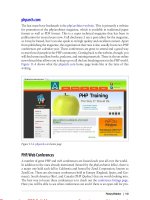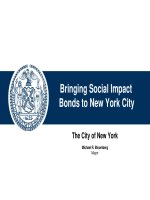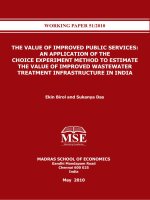The Value of Common Stocks pdf
Bạn đang xem bản rút gọn của tài liệu. Xem và tải ngay bản đầy đủ của tài liệu tại đây (111.32 KB, 11 trang )
CHAPTER 4
The Value of Common Stocks
Answers to Practice Questions
1. Newspaper exercise, answers will vary
2. The value of a share is the discounted value of all expected future dividends. Even
if the investor plans to hold a stock for only 5 years, for example, then, at the time
that the investor plans to sell the stock, it will be worth the discounted value of all
expected dividends from that point on. In fact, that is the value at which the
investor expects to sell the stock. Therefore, the present value of the stock today
is the present value of the expected dividend payments from years one through
five plus the present value of the year five value of the stock. This latter amount
is the present value today of all expected dividend payments after year five.
3. The market capitalization rate for a stock is the rate of return expected by the
investor. Since all securities in an equivalent risk class must be priced to offer
the same expected return, the market capitalization rate must equal the
opportunity cost of capital of investing in the stock.
4.
Expected Future Values Present Values
Horizon
Period
(H)
Dividend
(DIV
t
)
Price
(P
t
)
Cumulative
Dividends
Future
Price Total
0 100.00 100.00 100.00
1 10.00 105.00 8.70 91.30 100.00
2 10.50 110.25 16.64 83.36 100.00
3 11.03 115.76 23.89 76.11 100.00
4 11.58 121.55 30.51 69.50 100.00
10 15.51 162.89 59.74 40.26 100.00
20 25.27 265.33 83.79 16.21 100.00
50 109.21 1,146.74 98.94 1.06 100.00
100 1,252.39 13,150.13 99.99 0.01 100.00
Assumptions
1. Dividends increase by 5% per year compounded.
2. The capitalization rate is 15%.
27
5. a. Using the growing perpetuity formula, we have:
P
0
= Div
1
/(r – g)
73 = 1.68/(r - 0.085)
r = 0.108 = 10.8%
b. We know that:
Plowback ratio = 1.0 – payout ratio
Plowback ratio = 1.0 - 0.5 = 0.5
And, we also know that:
dividend growth rate = g = plowback ratio × ROE
g = 0.5 × 0.12 = 0.06 = 6.0%
Using this estimate of g, we have:
P
0
= Div
1
/(r – g)
73 = 1.68/(r - 0.06)
r = 0.083 = 8.3%
6. Using the growing perpetuity formula, we have:
P
0
= Div
1
/(r – g) = 2/(0.12 - 0.04) = $25
7.
$100.00
0.10
$10
r
DIV
P
1
A
===
$83.33
.0400.10
5
gr
DIV
P
1
B
=
−
=
−
=
×++++++=
6
7
6
6
5
5
4
4
3
3
2
2
1
1
C
1.10
1
0.10
DIV
1.10
DIV
1.10
DIV
1.10
DIV
1.10
DIV
1.10
DIV
1.10
DIV
P
$104.50
1.10
1
0.10
12.44
1.10
12.44
1.10
10.37
1.10
8.64
1.10
7.20
1.10
6.00
1.10
5.00
P
6654321
C
=
×++++++=
At a capitalization rate of 10 percent, Stock C is the most valuable.
For a capitalization rate of 7 percent, the calculations are similar. The results
are:
P
A
= $142.86
P
B
= $166.67
P
C
= $156.48
Therefore, Stock B is the most valuable.
28
8. a. We know that g, the growth rate of dividends and earnings, is given by:
g = plowback ratio × ROE
g = 0.40 × 0.20 = 0.08 = 8.0%
We know that:
r = (DIV
1
/P
0
) + g
r = dividend yield + growth rate
Therefore:
r = 0.04 + 0.08 = 0.12 = 12.0%
b. Dividend yield = 4%. Therefore:
DIV
1
/P
0
= 0.04
DIV
1
= 0.04 × P
0
A plowback ratio of 0.4 implies a payout ratio of 0.6, and hence:
DIV
1
/EPS
1
= 0.6
DIV
1
= 0.6 × EPS
1
Equating these two expressions for DIV
1
gives a relationship between
price and earnings per share:
0.04 × P
0
= 0.6 × EPS
1
P
0
/EPS
1
= 15
Also, we know that:
−×=
00
1
P
PVGO
1r
P
EPS
With (P
0
/EPS
1
) = 15 and r = 0.12, the ratio of the present value of growth
opportunities to price is 44.4 percent. Thus, if there are suddenly no
future investment opportunities, the stock price will decrease by 44.4
percent.
c. In Part (b), all future investment opportunities are assumed to have a net
present value of zero. If all future investment opportunities have a rate of
return equal to the capitalization rate, this is equivalent to the statement
that the net present value of these investment opportunities is zero.
Hence, the impact on share price is the same as in Part (b).
9. Internet exercise; answers will vary depending on time period.
29
10. Internet exercise; answers will vary depending on time period.
11. Using the concept that the price of a share of common stock is equal to the
present value of the future dividends, we have:
−
×
+
+
+
+
+
+
+
=
g)(r
DIV
r)(1
1
r)(1
DIV
r)(1
DIV
r)(1
DIV
P
4
33
3
2
21
−
×
×
+
+
+
+
+
+
+
=
)06.0r(
)06.13(
)r1(
1
)r1(
3
)r1(
2
)r1(
1
50
332
Using trial and error, we find that r is approximately 11.1 percent.
12. There are two reasons why the corresponding earnings-price ratios are not
accurate measures of the expected rates of return.
First, the expected rate of return is based on future expected earnings; the price-
earnings ratios reported in the press are based on past actual earnings. In
general, these earnings figures are different.
Second, we know that:
−=
00
1
P
PVGO
1r
P
EPS
Hence, the earnings-price ratio is equal to the expected rate of return only if
PVGO is zero.
13. a. An Incorrect Application. Hotshot Semiconductor’s earnings and
dividends have grown by 30 percent per year since the firm’s founding ten
years ago. Current stock price is $100, and next year’s dividend is
projected at $1.25. Thus:
31.25%.31250.300
100
1.25
g
P
DIV
r
0
1
==+=+=
This is wrong because the formula assumes perpetual growth; it is not
possible for Hotshot to grow at 30 percent per year forever.
30
A Correct Application. The formula might be correctly applied to the Old
Faithful Railroad, which has been growing at a steady 5 percent rate for
decades. Its EPS
1
= $10, DIV
1
= $5, and P
0
= $100. Thus:
10.0%.100.050
100
5
g
P
DIV
r
0
1
==+=+=
Even here, you should be careful not to blindly project past growth into the
future. If Old Faithful hauls coal, an energy crisis could turn it into a
growth stock.
b. An Incorrect Application . Hotshot has current earnings of $5.00 per share.
Thus:
5.0%.050
100
5
P
EPS
r
0
1
====
This is too low to be realistic. The reason P
0
is so high relative to earnings
is not that r is low, but rather that Hotshot is endowed with valuable growth
opportunities. Suppose PVGO = $60:
PVGO
r
EPS
P
1
0
+=
60
r
5
100 +=
Therefore, r = 12.5%
A Correct Application. Unfortunately, Old Faithful has run out of valuable
growth opportunities. Since PVGO = 0:
PVGO
r
EPS
P
1
0
+=
0
r
10
100 +=
Therefore, r = 10.0%
31
14.
gr
NPV
r
EPS
price Share
1
−
+=
Therefore:
0.15)(r
NPV
r
EPS
Ρ
αα
1α
α
−
+=
α
0.08)(r
NPV
r
EPS
Ρ
β
β
β
β1
β
−
+=
The statement in the question implies the following:
−
+
−
>
−
+
− 0.15)(r
NPV
r
EPS
0.15)(r
NPV
0.08)(r
NPV
r
EPS
0.08)(r
NPV
α
α
α
α1
α
α
β
β
β
β1
β
β
Rearranging, we have:
11
EPS
r
)08.0r(
NPV
EPS
r
)15.0r(
NPV
β
β
β
β
α
α
α
α
×
−
<×
−
a. NPV
α
< NPV
β
, everything else equal.
b. (r
α
- 0.15) > (r
β
- 0.08), everything else equal.
c.
0.08)(r
NPV
0.15)(r
NPV
β
β
α
α
−
<
−
, everything else equal.
c.
β1
β
α1
α
EPS
r
EPS
r
<
, everything else equal.
15. a. Growth-Tech’s stock price should be:
23.81
.08)0(0.12
1.24
(1.12)
1
(1.12)
1.15
(1.12)
0.60
(1.12)
0.50
P
332
$=
−
×+++=
b. The horizon value contributes:
$22.07
.08)0(0.12
1.24
(1.12)
1
)PV(P
3
H
=
−
×=
32
c. Without PVGO, P
3
would equal earnings for year 4 capitalized at
12 percent:
$20.75
0.12
2.49
=
Therefore: PVGO = $31.00 - $20.75 = $10.25
d. The PVGO of $10.25 is lost at year 3. Therefore, the current stock price
of $23.81 will decline by:
$7.30
(1.12)
10.25
3
=
The new stock price will be $23.81 - $7.30 = $16.51
16.Internet exercise; answers will vary depending on time period.
17. Internet exercise; answers will vary.
18. Internet exercise; answers will vary.
19. a. Here we can apply the standard growing perpetuity formula with
DIV
1
= $4, g = 0.04 and P
0
= $100:
8.0%.080.040
100
4
g
P
DIV
r
0
1
==+=+=
The $4 dividend is 60 percent of earnings. Thus:
EPS
1
= 4/0.6 = $6.67
Also:
PVGO
r
EPS
P
1
0
+=
PVGO
0.08
6.67
100 +=
PVGO = $16.63
33
b. DIV
1
will decrease to: (0.20 × 6.67) = $1.33
However, by plowing back 80 percent of earnings, CSI will grow by
8 percent per year for five years. Thus:
Year 1 2 3 4 5 6 7, 8 . . .
DIV
t
1.33 1.44 1.56 1.68 1.81 5.88 Continued
growth at
EPS
t
6.67 7.20 7.78 8.40 9.07 9.80 4 percent
Note that DIV
6
increases sharply as the firm switches back to a 60 percent
payout policy. Forecasted stock price in year 5 is:
$147
.0400.08
5.88
gr
DIV
P
6
5
=
−
=
−
=
Therefore, CSI’s stock price will increase to:
$106.22
1.08
1471.81
1.08
1.68
1.08
1.56
1.08
1.44
1.08
1.33
P
5432
0
=
+
++++=
20. Formulas for calculating PV(P
H
) include the following:
a. PV(P
H
) = (EPS
H
/r) + PVGO
where EPS
H
is the firm’s earnings per share at the horizon date.
(This formula would be the easiest to apply if PVGO = 0.)
b. PV(P
H
) = EPS
H
× (P/E)
C
where (P/E)
C
is the P/E ratio for comparable firms.
(This formula would be a good choice if comparable firms can be readily
identified.)
c. PV(P
H
) = BV
H
× (MV/BV)
C
where BV
H
is the firm’s book value per share at the horizon date, and
(MV/BV)
C
is the market-book ratio for comparable firms.
(This formula would be a good choice if comparable firms can be readily
identified.)
d. PV(P
H
) = C
H + 1
/(r – g)
where C
H + 1
is the firm’s cash flow in the subsequent time period.
(This formula would be a good choice if the assumption of growth at a
constant rate g for the foreseeable future is a reasonable assumption.)
34
21. a.
Year
1 2 3 4 5 6 7 8 9 10
Asset value 10.00 11.50 13.23 15.21 17.49 19.76 22.33 23.67 25.09 26.60
Earnings 1.20 1.38 1.59 1.83 2.10 2.37 2.68 2.84 3.01 3.20
Investment 1.50 1.73 1.98 2.28 2.27 2.57 1.34 1.42 1.51 1.60
Free cash flow -0.30 -0.35 -0.39 -0.45 -0.17 -0.20 1.34 1.42 1.50 1.60
Earnings growth 20.0% 20.0% 20.0% 20.0% 20.0% 13.0% 13.0% 6.0% 6.0% 6.0%
The present value of the near-term flows (i.e., years 1 through 6) is -$1.38
The present value of the horizon value is:
$18.91
.06)0(0.10
1.34
(1.10)
1
)PV(P
6
H
=
−
×=
Therefore, the present value of the free cash flows is:
($18.91-$1.38) = $17.53
The present value of the near term cash flows increases because the
amount of investment each year decreases. However, the present value
of the horizon value decreases by a greater amount, so that the total
present value decreases.
b. With one million shares currently outstanding, price per share is:
($17.53 million/1 million shares) = $17.53
The amount of financing required is $1.38 million, so the number of shares
to be issued is: ($1.38 million/$17.53) = 79,000 shares (approximately)
c. (i) $17.53 million/1 million shares = $17.53 per share
(ii) previously outstanding shares/total shares =
1 million/1.079 million = 0.9268
0.9268 × $18.91 = $17.53
22. The value of the company increases from $100 million to $200 million.
The value of each share remains the same at $10.
35
23.
Expected Future Values Present Values
Horizon
Period
(H)
Dividend
(DIV
t
)
Price
(P
t
)
Cumulative
Dividends
Future
Price Total
0 100.00 100.00 100.00
1 15.00 100.00 13.04 86.96 100.00
2 5.00 110.00 16.82 83.18 100.00
3 5.50 121.00 20.44 79.56 100.00
4 6.05 133.10 23.90 76.10 100.00
10 10.72 235.79 41.72 58.28 100.00
20 27.80 611.59 62.63 37.37 100.00
50 485.09 10,671.90 90.15 9.85 100.00
100 56,944.68 1,252,782.94 98.93 1.07 100.00
In order to pay the extra dividend, the company needs to raise an extra $10 per
share in year 1. The new shareholders who provide this cash will demand a
dividends of $0.50 per share in year 2, $0.55 in year 3, and so on. Thus, each
old share will receive dividends of $15 in year 1, ($5.50 – $0.50) = $5 in year 2,
($6.05 – $0.55) = $5.50 in year 3, and so on. The present value of a share at
year 1 is computed as follows:
$100.00
1.15
1
0.10-0.15
$5
1.15
$15
PV =
×+=
36
Challenge Questions
1. There is something of an inconsistency in Practice Question 11 since the
dividends are growing at a very high rate initially. This high growth rate suggests
the company is investing heavily in its future. Free cash flow equals cash
generated net of all costs, taxes, and positive NPV investments. If investment
opportunities are abundant, free cash flow can be negative when investment
outlays are large. Hence, where do the funds to pay the increasing dividends
come from?
At some point in time, competition is likely to drive ROE down to the cost of
equity, at which point investment will decrease and free cash flow will turn
positive.
2. From the equation given in the problem, it follows that:
bROE)/(r
b1
ROE)(br
b)(1ROE
BVPS
P
0
−
−
=
×−
−×
=
Consider three cases:
ROE < r ⇒ (P
0
/BVPS) < 1
ROE = r ⇒ (P
0
/BVPS) = 1
ROE > r ⇒ (P
0
/BVPS) > 1
Thus, as ROE increases, the price-to-book ratio also increases, and when ROE =
r, price-to-book equals one.
3. Assume the portfolio value given, $100 million, is the value as of the end of the
first year. Then, assuming constant growth, the value of the contract is given by
the first payment (0.5 percent of portfolio value) divided by (r – g). Also:
r = dividend yield + growth rate
Hence:
r - growth rate = dividend yield = 0.05 = 5.0%
Thus, the value of the contract, V, is:
million $10
0.05
million) ($1000.005
V =
×
=
37









